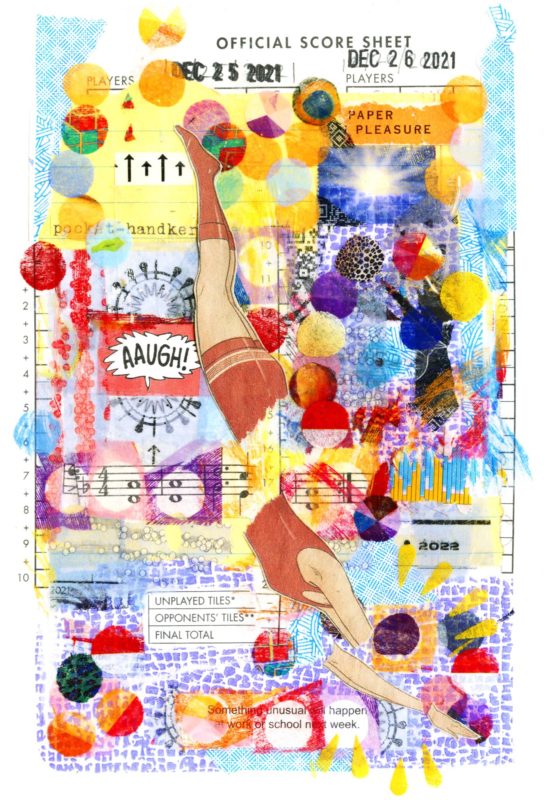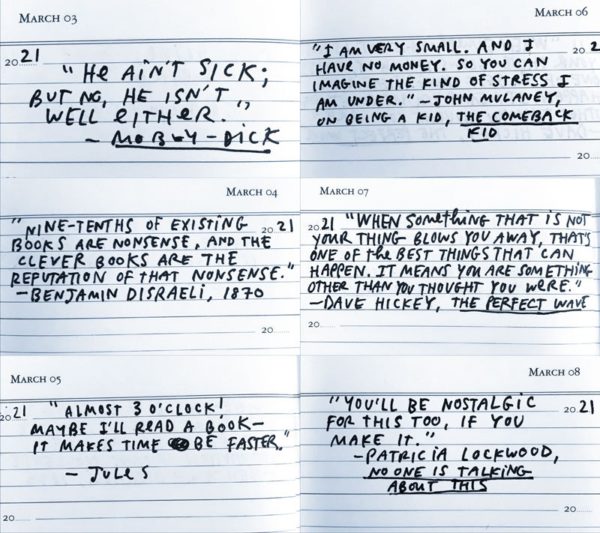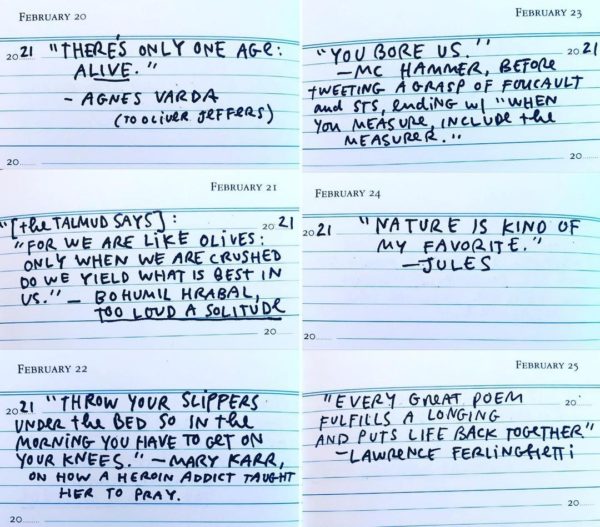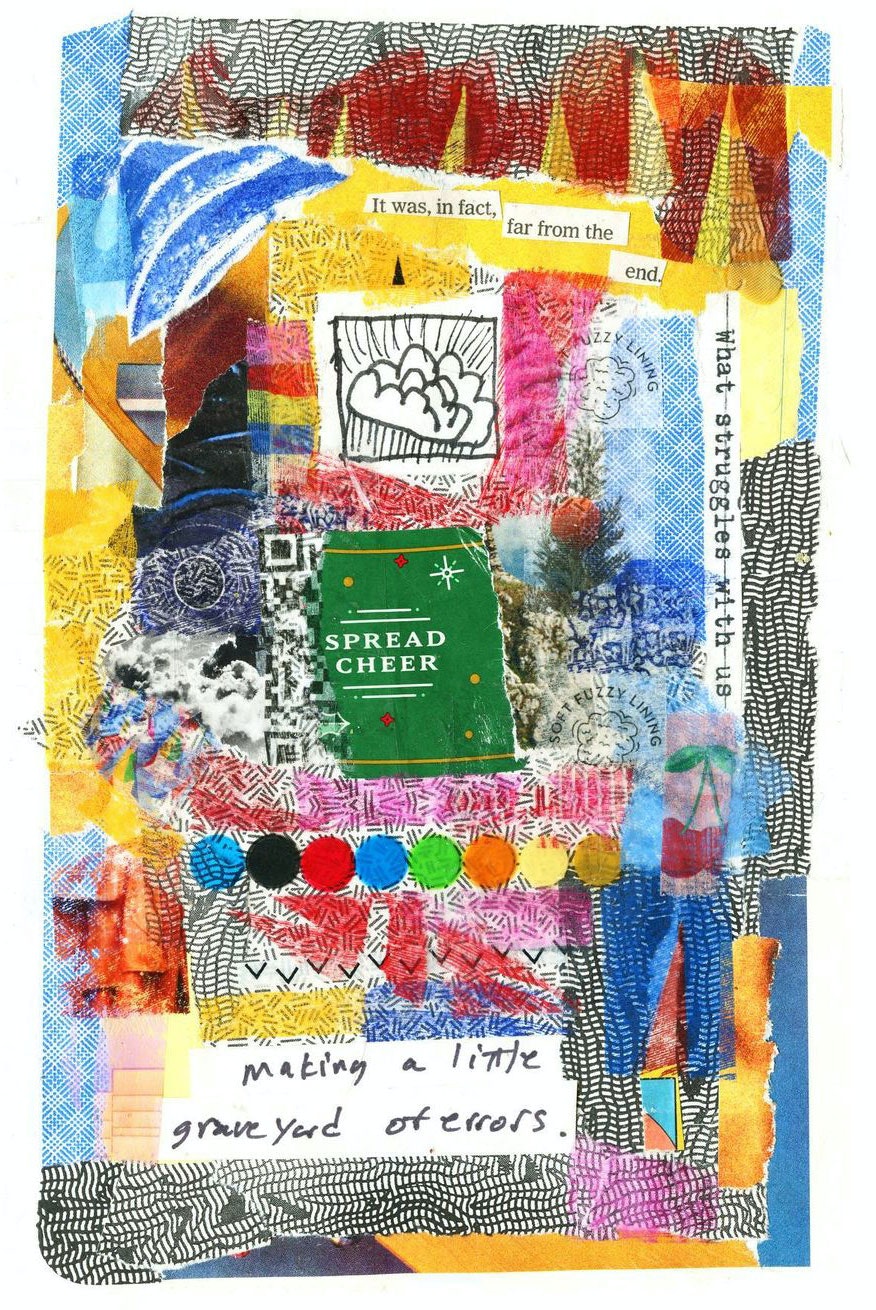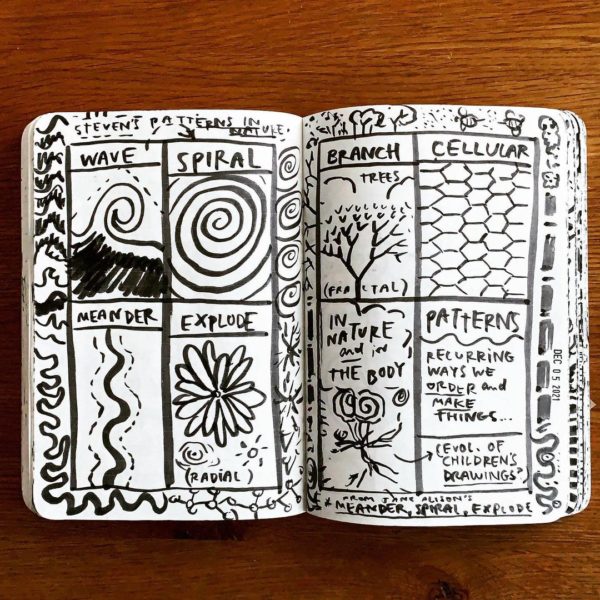- Getting the whole household vaccinated.
- Putting in a pool! Swimming in the pool! Reading big fat paperbacks while floating in the pool! Drawing comix and doodling and writing poems in the pool! Talking on the phone while cleaning the pool! Nightswimming with booze in a plastic cup. Damselflies mating on my shoulder. The way the sunlight reflecting off the pool casts weird light all over the house. Waking up on my pizza raft in late October with a mild sunburn. Discovering that you can still float in the pool even when it’s too cold to swim. (Can you tell I’m a Pisces rising?)
- Walking. (Especially in the morning.) The Shoal Creek greenbelt.
- The continuing adventures of Mr. and Mrs. Coconut the Owl(s). Having a house built for them. Seeing them mate on a tree branch at dusk. Making pictures and posters of them whenever they went missing. Feeling like Tony Soprano when the ducks flew away. Comforting myself in their absence with the livestream of their cousins, Merlin and Minerva. Finding out Picasso had an owl. How Mr. Coconut returned with the partial lunar eclipse.
- Playing The Legend of Zelda: Breath of the Wild on my kids’ Nintendo Switch. Disappearing into Hyrule. Watching Meg get into Animal Crossing. Mario Kart tournaments with the whole family. Being asked to play Minecraft and the boys teaching me to make a rollercoaster.
- Family pizza and a movie night. So many good movies, and at least two masterpieces: Kiki’s Delivery Service and Paddington 2.
- Playing piano. Learning Debussy’s first arabesque and “Bruyeres.” Guaraldi’s “Great Pumpkin Waltz.” Even learning the Succession theme. How I can hear a song 1,000 times, but the minute I learn it on the piano, realizing how much I didn’t know it.
- Starting a 5-year commonplace diary and writing a favorite sentence in it every day.
- My magic brush pen.
- Prismacolor Ebony Graphites.
- Copying out a poem on my typewriter and picking it apart.
- Newsletter 2.0. All my kind readers.
- Starting the Read Like an Artist book club with Literati.
- Dipping into the archives and writing the afterward for the 10th anniversary edition of Steal Like An Artist. Learning InDesign well enough that I could lay out the whole Afterword myself.
- How my books continue to have a life out in the world. YouTuber Ali Abdaal sharing how Show Your Work! changed his life and the book finding an even bigger audience. How people are slowly discovering that Keep Going is basically a pandemic manual.
- Making collages out of used fireworks and lifted type and cyanotypes of dead things I find in the yard. Losing myself. Getting into the flow state. Stepping into the portal.
- The tenderness of school pickups and drop-offs. Proper distance. What George Saunders calls “that airport feeling.”
- Driving around with the kids, blasting “Surfin’ Bird” and the Bluey soundtrack in the car.
- A road trip to Laity Lodge and the Frio Canyon. Making a fire and sitting out underneath the stars. (Jules: “It looks like the fire is trying to tell us a story.”)
- My Apple Watch and Apple AirPods, two pieces of technology I initially scoffed at that Meg bought me and I ended up loving.
- Making a page for my zines.
- Spiffing up my speaking page and having our best year ever. Having a good rig, so I can talk and draw at the same time. Speaking to a quilting conference about my tape quilts. Working on more than one talk at a time. All my great clients.
- Conversational shortcuts. Not greeting people with, “How are you?” but saying, “It’s nice to see you.”
- A real January snow day in Texas. (Which was later overshadowed by the awful winter storm in February.) How much more the new growth of spring meant after the storm. How the palms regrew their fronds after being trimmed.
- Trying to actually take weekends off. Pressing Schedule Send.
- Letting things sit until they tell you what they want to be. Joy Williams saying more people should get writer’s block. (How Elton John used to say to Billy Joel, “Why don’t you put out more albums?” and Billy Joel would reply, “Why don’t you put out less?”) Remembering that nobody wants to read a book. Making covers for books I don’t intend to write. Knowing the difference between exploiting and exploring.
- Listening to short stories instead of podcasts. Typing a short story writer’s name into my podcast app and seeing what comes up.
- How some books suck you in and some books spin you out.
- Tales of marginalia.
- Leaving notes of encouragement to myself in really long books.
- Reading like a diver — sometimes going deep, sometimes skimming. Reading like a bird of prey — swooping and perching.
- Reading with a blade and a glue stick.
- The Thoreau/Emerson/James trilogy of biographer Robert D. Richardson.
- Iain McGilchrist’s The Master and His Emissary.
- Reading about physics. Leonard Shlain’s Art & Physics. 4 or 5 books by Carlo Rovelli. Benjamin Labatut’s When We Cease To Understand The World.
- Accumulating more gardening metaphors! How knowing a little bit about plants helped me realize I’m not languishing, I’m dormant. Anne Patchett on being a compost heap. Learning what seeds look like. Dormancy and Wintering. Not seizing the day — plucking it! Not being a pirate or a farmer, but a pirate gardener.
- Becoming someone who takes comfort in mindless yard work. Literally tending my plot. Moving rocks with my wheelbarrow and shovel. Mowing with our old-fashioned push mower. Raking leaves. Power washing. Growing grass. My gardener’s hat.
- Trying to love the squirrels, even though I hate them so much for invading the owl house and dropping half-eaten pecans all over the yard.
- The total chaos of having a 6-year-old and a 9-year-old. One still attached to that little kid magic, and one on the cusp of becoming a pre-teen. The roughhousing. The fights and the love. Putting their arms around each other while watching TV. How much they read. How Jules leaves amazing drawings all over the house. How he sometimes keeps a diary. How Owen does the crossword in the NYTimes Kids’ Section. How they play keyboards at opposite ends of the house and make it sound like a Guitar Center showroom. How much they love Wheel of Fortune. How their dresser is basically a museum of technology. All the funny stuff they say. How they are always making fun of me. Their short film, “Cowardly Papa.” Wondering why Jules always drew me with a goofy oversized beard and then realizing it’s because that’s literally how he sees me.
- Not trying to be a great parent, just a “good enough” parent. Telling them as much as they need to know, and no more. Playing a long game. Practicing patience. How Meg looks up a joke online and writes it on a post-it note that she sticks in their school lunches.
- Drawing Batman cowls and Mario hats and mustaches on people in the NYTimes. Learning the kind of math they teach in school now. Making fart collages! Playing with their spin art kit. Printmaking with vegetables like leftover peppers and onions. Painting over Jules’ drawings.
- Rethinking Owen’s stutter as “Our Stutter,” because it’s something we share. All the cool people in the stuttering community I’ve met. Brunch with John Hendrickson. JJJJJerome Ellis’s The Clearing.
- How much we all still have to learn about ourselves and each other. How I wrote a post about aphantasia — the inability to make pictures in your head — and Meghan said, “I think I have that.” (She does!)
- This photo Jules took of me.
- The United States Postal Service. Getting mail from artists I love. Jules sending a letter to Nintendo and getting a response.
- The re-opening of our local library branch. That feeling when your holds come in. Browsing the kids’ graphic novel section for the boys. My “What’s more punk than the public library?” t-shirt.
- Kind nurses.
- The idea that curiosity is not a luxury. Writing as just pointing at things. Playing an ignorant guy who’s curious.
- Walking past a discarded beer can so many times I decided to turn it into installation art.
- Trying to love Austin, as much as it is changing. Shouting “That’s right baby, when you got it flaunt it!” at a couple parked in a Ferrari on Burnet Road on Easter Day.
- A woman on Nextdoor asking for a recommendation for ghost removal and how many people knew “a guy” and also had very specific advice.
- Thinking of input as collage. Learning that when Joy Division were making “Love Will Tear us Apart,” they were listening to Frank Sinatra’s Greatest Hits and Sparks’ “No. 1 in Heaven.” Switching on PBS for 10 minutes every night after whatever we’ve finishing watching and seeing if there are any connections. How reading Carlo Rovelli and watching Michael Mann at the same time means they are now entangled in my brain.
- Jarvis Cocker singing Sondheim’s “I’m Still Here.”
- The Kata dudes shouting at the Olympics and the kids being bewildered by the spectacle.
- Verlyn Klinkenborg’s Several Short Sentences About Writing.
- Denis Johnson’s commonplace book.
- Thinking about writing as a spiritual practice. Writing pandemic prayers. Making art as a souvenir of gratitude. Not believing in myself, just trying to keep the channel open. Waiting for that tingle in the scalp. Embracing clichés, puns, and hooks. Skipping the boring parts. Trying to rewind my attention. Searching outside the algorithm. Throwing out the instructions. Not killing my darlings, but relocating them.
- The Apple Notes app, how it syncs between phone and computer, sure, but also just crossing things out on a legal pad.
- Upgrading to an industrial strength date stamp.
- My Goldilocks theory of creativity: how there’s a sweet spot when life is just annoying enough that writing is a nice alternative.
- Keeping in mind how toxic fame is. Wishing I had a pseudonym or some heteronyms.
- How Instagram isn’t completely terrible yet. Gary Panter’s Instagram index cards. Liana Finck’s new mom cartoons. Monty Don’s gardens. Thor Harris’s life hacks.
- The woodcuts of Antonio Frasconi.
- The J. Crew pocket t-shirts that Meg buys me on clearance.
- Getting in Costco Connection!
- Reading an essay and then searching the writer’s Twitter feed to see the tweets that led up to it.
- Thinking about time. Geologic time and the trouble with months. Time as the stream you go fishing in. Almanacs and cyclical time. How what you think is boring now may be interesting in the future.
- Watching skating videos when I’m missing California.
- Listening to the Radio Garden app.
- Listening to a bunch of interviews with the same interesting person until you memorize their sound bites and big ideas.
- Watching TV! The Knick! The Mandalorian! The White Lotus! Hacks! Grand Designs. The Durrells in Corfu. What We Do in the Shadows. Reservation Dogs. All Creatures Great and Small. Sex Education. The Great. Ghosts! Squid Game. J.B. Smoove as Leon on Curb Your Enthusiasm. How being a Roy Kent is better than being a Ted Lasso. Seeing Rick Steves on TV and shouting, in Chappelle’s Rick James voice, “You want to smoke with the ol’ boy Rick Steves?!?” Trash TV! Motel Makeover! How no matter how many episodes of Magnum, P.I. I wander into halfway through, I still can’t figure out what’s going on. Discovering we have 80s and 90s music video channels on the TV. How, at certain point in the year, Marky Mark’s “Good Vibrations” came on at the same time every night. The story of “Thong Song.” The small thrill when the Roku TV changes backgrounds with the season.
- Listening to music! Blasting Depeche Mode all summer after watching Depeche Mode 101. Finally getting into Sparks thanks to The Sparks Brothers. “Bruyeres” recorded at home by the pianist Víkingur Ólafsson. Pharaoh Sanders and Floating Points’ Promises. Billy Nomates’ Emergency Telephone EP. (Made in her shed!) Dry Cleaning’s New Long Leg. The “Post-Brexit New Wave.” Horse Lords’ The Common Task. Suzanne Ciani. Laura Mvula’s Pink Noise. h hunt’s Playing Piano For Dad. Noveller. The Krautrock-inspired Lower Dens record, Nootropics. A playlist of tracks from the label Tasty Morsels. Silk Sonic’s “Smokin Out The Window.”
- The way Jonathan Richman talks about The Velvet Underground. How even Hans Zimmer describes the Hans Zimmer sound as “that low drone-y thingie.” How Charlie Watts pulled off the hi-hat when he hit his snare.
- How, somehow, I’m not sick of The Beatles? Revolution in the Head. Making a playlist of songs they listened to. How hard Paul tried. John Lennon singing “Cathy’s Clown.” The “God” episode of Song Exploder. Even Ringo’s fart.
- Listening to a sweet playlist and checking to see who made it and realizing it was ME.
- Watching movies! Mostly old movies. Watching half a movie today, half a movie tomorrow. How it was a particularly great year for music movies. Hail Satan! The Duellists. Midnight Run. Dangerous Liaisons. Hustlers. The Lady from Shanghai. Captain Blood. Val. Re-watching Michael Mann’s The Last of the Mohicans with a couple of my buddies online, then rewatching Heat and Collateral. Even Dune! (Especially the David Lynch version.) How if you put Flea in your documentary, he will steal the show. Expecting nothing from Dunkirk or Tenet, and liking them both. (Same for Inherent Vice.) The Donut King. Plan B. Watching Fast 9 in my friend’s backyard and thinking about how much it aligns with The Heroine’s Journey. Derek DelGaudio’s In and Of Itself. Bo Burnham’s Inside.
- Reading outside in the yard and smelling something delicious and thinking, “Dang, somebody is having something good for dinner,” then coming inside and discovering that somebody is ME.
- Meg’s St. Patrick’s Day feast: corned beef and potatoes and sauerkraut and soda bread and Guinness.
- Oysters, clam chowder, a cheeseburger, and affogato at Clark’s, out in their parking lot.
- The carne asada burrito at T-Loc’s.
- So much takeout and delivery. Stiles and Switch BBQ. Tso’s chinese. Enchiladas y Mas. Bagels from Nervous Charlie’s. Sushi from Kome.
- Strawberry ice cream and pretzels.
- Goodies from Milk Barn Farm.
- Watching Meg fix the dishwasher after watching a YouTube video. The smart LED light Meg installed in Owen’s noise nook. The towel warmer rack she installed in the bathroom.
- Fixing my broken prescription sunglasses by using frames from another pair of glasses.
- Thinking about the harmony of tension, how most things in life run on the coincidence of opposites, like the string of a guitar slung between two tuning pegs: too slack, it makes no music, too tight, it snaps.
- Signing books at Bookpeople. Walking into Kinokuniya and Black Pearl Books to shop and finding out they stocked my books. Meeting booksellers and getting to thank them in person.
- Having a really great office, losing the office, and then dreaming about having my own studio again someday, while also knowing that nothing will ever beat working at the kitchen table in the morning sunshine.
- When Willie and Merle, the neighbor cats, decided they lived in our yard now. The time Merle ran into the house and a wild chase ensued. How they slept on the porch all night and I had to decide in the morning whether to go outside with my coffee or let them sleep. How much I missed them when they moved to Elgin.
- Halloween, the highpoint of the year, in between COVID spikes. Carving pumpkins. Trick or treating with friends and dancing in the streets. The painting I found on the sidewalk.
- Playing Uno and Five Card Nancy with the kids. Playing Scrabble with mom.
- Approaching 40, realizing how much I can’t afford to lose friends. Calling them on the phone. Meeting up. Having an (outdoor) lunch. Planning to get a bike so we can go for a ride together.
- People looking through my telescope and seeing Jupiter’s moons and Saturn’s rings for the first time.
- Re-reading letters from my grandma and writing her obituary.
- KUTX’s Christmas mix, which I swear made Christmas 100% merrier.
- Celebrating our 15th anniversary with Dairy Queen.
- The steeple of the church near our house, how I see it in the distance and know I’m almost home.
- The sunset over the river at Laguna Gloria.
- Hearing the people I love laugh.
- Taking afternoon naps.
If you liked this list, you’ll love my newsletter.
Read my top 100 lists from previous years here.
